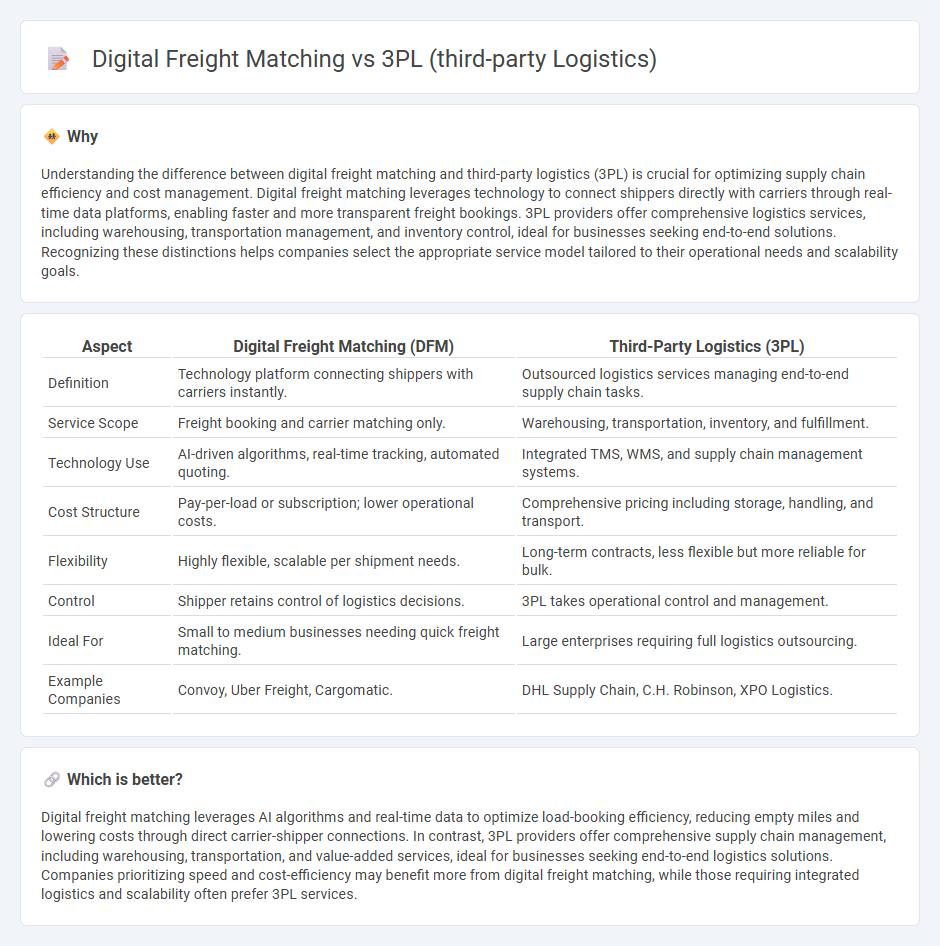
Digital freight matching leverages advanced algorithms and real-time data to connect shippers directly with carriers, enhancing efficiency and reducing transportation costs. Unlike traditional third-party logistics (3PL) providers, which manage multiple aspects of the supply chain including warehousing and distribution, digital freight platforms focus primarily on optimizing freight load matching and route planning. Explore how digital freight matching compares with 3PL services to determine the best logistics solution for your business needs.
Why it is important
Understanding the difference between digital freight matching and third-party logistics (3PL) is crucial for optimizing supply chain efficiency and cost management. Digital freight matching leverages technology to connect shippers directly with carriers through real-time data platforms, enabling faster and more transparent freight bookings. 3PL providers offer comprehensive logistics services, including warehousing, transportation management, and inventory control, ideal for businesses seeking end-to-end solutions. Recognizing these distinctions helps companies select the appropriate service model tailored to their operational needs and scalability goals.
Comparison Table
| Aspect | Digital Freight Matching (DFM) | Third-Party Logistics (3PL) |
|---|---|---|
| Definition | Technology platform connecting shippers with carriers instantly. | Outsourced logistics services managing end-to-end supply chain tasks. |
| Service Scope | Freight booking and carrier matching only. | Warehousing, transportation, inventory, and fulfillment. |
| Technology Use | AI-driven algorithms, real-time tracking, automated quoting. | Integrated TMS, WMS, and supply chain management systems. |
| Cost Structure | Pay-per-load or subscription; lower operational costs. | Comprehensive pricing including storage, handling, and transport. |
| Flexibility | Highly flexible, scalable per shipment needs. | Long-term contracts, less flexible but more reliable for bulk. |
| Control | Shipper retains control of logistics decisions. | 3PL takes operational control and management. |
| Ideal For | Small to medium businesses needing quick freight matching. | Large enterprises requiring full logistics outsourcing. |
| Example Companies | Convoy, Uber Freight, Cargomatic. | DHL Supply Chain, C.H. Robinson, XPO Logistics. |
Which is better?
Digital freight matching leverages AI algorithms and real-time data to optimize load-booking efficiency, reducing empty miles and lowering costs through direct carrier-shipper connections. In contrast, 3PL providers offer comprehensive supply chain management, including warehousing, transportation, and value-added services, ideal for businesses seeking end-to-end logistics solutions. Companies prioritizing speed and cost-efficiency may benefit more from digital freight matching, while those requiring integrated logistics and scalability often prefer 3PL services.
Connection
Digital freight matching leverages advanced algorithms and real-time data to connect shippers with carriers, streamlining the transportation process. Third-party logistics (3PL) providers integrate digital freight matching platforms to enhance supply chain efficiency, reduce empty miles, and optimize load capacity. This synergy enables 3PL companies to offer dynamic, cost-effective shipping solutions while improving transparency and delivery times.
Key Terms
**3PL:**
3PL (third-party logistics) providers offer comprehensive supply chain management, integrating warehousing, transportation, and fulfillment services to optimize efficiency and reduce operational costs. With expertise in inventory management, route optimization, and freight consolidation, 3PLs enhance flexibility and scalability for businesses handling complex logistics. Discover how partnering with a 3PL can transform your logistics strategy and boost supply chain performance.
Outsourcing
Third-party logistics (3PL) outsourcing involves delegating comprehensive logistics operations, including warehousing, transportation, and inventory management, to an external provider, enabling businesses to leverage established networks and expertise. Digital freight matching, by contrast, focuses on utilizing technology platforms to connect shippers with carriers in real-time for specific freight moves, optimizing route efficiency and load capacity without full operational outsourcing. Explore the benefits and strategic applications of 3PL versus digital freight matching to determine the best outsourcing model for your supply chain needs.
Warehousing
Third-party logistics (3PL) providers offer comprehensive warehousing solutions by managing inventory, storage, and order fulfillment across multiple client businesses, ensuring operational efficiency and scalability. Digital freight matching platforms primarily focus on optimizing freight transportation by connecting shippers and carriers in real-time, with limited capabilities in warehousing services. Explore how integrating 3PL warehousing with digital freight matching can enhance supply chain agility and cost-effectiveness.
Source and External Links
What is a 3PL? Third-party logistics definition, process, and resources - A 3PL (third-party logistics) provider is a business that offers outsourced logistics services such as warehousing, inventory management, order fulfillment, transportation, and sometimes global supply chain support, helping companies streamline their supply chains and focus on growth.
What is 3PL (third-party logistics)? | Definition from TechTarget - 3PL providers offer outsourced logistics services including storing, shipping, and managing procurement and fulfillment activities, enabling businesses to control shipping costs effectively while focusing on their core operations.
How 3PLs Revolutionize Logistics and Supply Chain Management - Third-party logistics companies transform supply chains by outsourcing logistics functions like transportation, warehousing, packaging, and customs brokerage, providing businesses with expertise, technology, and infrastructure for improved efficiency and growth.
 dowidth.com
dowidth.com